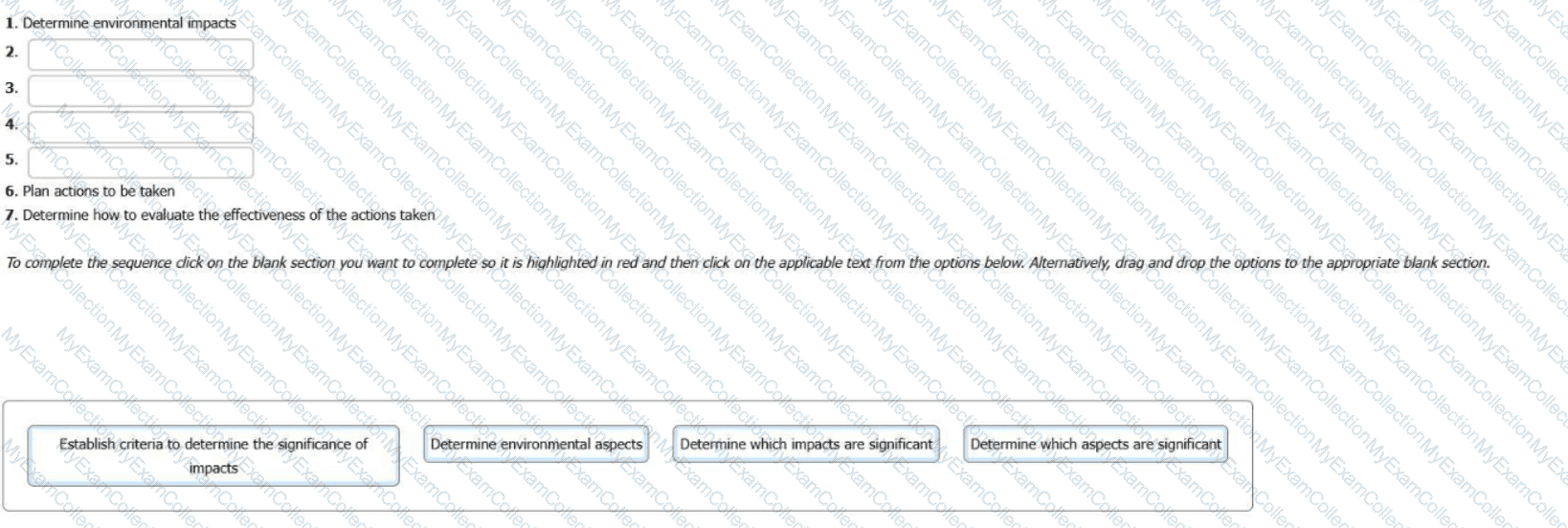During a Stage 1 audit, the EMS Manager asks that the audit includes coverage of a new storage site on the other side of town that they have taken over since the application was made.
Which two of the following actions should the auditor take?
An internal auditor of a manufacturer of aluminium products for the car industry raised a nonconformity against section 6.2.2 of ISO 14001 in Report IA202. The nonconformity (NC3) stated:
"Top management has not analysed why none of the environmental objectives set for the last year have been met."
A third-party auditor reviewing the internal audit process came across the nonconformity and found that no corrective action was documented. The EMS Manager confirmed no action had been taken, but added he expected a number of objectives to be achieved in the next three months so there was no need for further action. He explained in confidence that the organisation was fighting a takeover bid and resources for environmental projects had been cut.
From the information, select three non-conformities options that the auditor could raise to ISO 14001.
In the case of ISO 14001 EMS audits that follow the recommendations of ISO 19011, which two of the following statements are true?
Considering the requirements of clauses 6.1.2 and 6.1.4 of ISO 14001:2015, put the actions in the correct order to complete a process/task.

Sparkle is an organisation that provides mobile car cleaning services at customers' premises. It has been certified to ISO 14001 for some time and has appointed a full-time Environmental Management System Manager. The audit plan during a surveillance audit includes continual improvement and the auditor asks to see the most recent management review meeting minutes.
The minutes indicate that the Environmental Management System Manager reported that the last review of the organisation's environmental legislation register was made three years ago instead of annually as planned in the Environmental Management System. At that time, he asked for finances to employ a legislation expert to update the register but was denied the request by top management on the basis that it was unlikely that many changes to legislation had occurred. No related improvement actions were documented in the minutes.
Based on the scenario, select the two options which best describe the evidence for raising such a non-conformity.
A chain of 10 paint shops in a city has established an EMS following the requirements of ISO 14001, which was third-party certified 10 years ago. You are performing a second-party audit. The audit plan included an interview with the General Manager (GM). The dialogue was as follows:
You: Hi, good evening, I have seen a well-developed environmental risk assessment process. However, I did not find the identification of emergency situations included in the results of this process. The Environmental Manager (EM) could not provide me with an acceptable answer to this question.
GM: The EM joined us 2 months ago, and he may not know some decisions we made some time ago, when we first certified our EMS. During those days, I met with all 10 supervisors and asked them what the emergencies were that they feared most. They unanimously said: fire. That was it. This is the only emergency we care of. As far as I remember we do not test the plan very often because the supervisors of all our 10 shops know it very well. The auditors of our certification body accepted this. We did not have a fire in the last 10 years.
What evidence would you need to review to determine conformity with ISO 14001 in this scenario? Select six.
Whistlekleen is a national dry cleaning and laundry organisation with 50 shops. You are conducting an EMS surveillance audit of Head Office and are sampling environmental performance measurement. You find that 80 per cent of failures to meet performance criteria originate from five shops in the same region. Most of these failures relate to the release of volatile organic compounds (VOCs) that exceeds regulations. The Environmental Manager tells you that these are the oldest shops in the organisation. The cleaning equipment needs replacing but the organisation cannot afford it at the moment.
On raising the matter with senior management, you are told that there are plans to replace the equipment in these shops over the next five years.
Select two options that apply to how you should respond to the information given.
The audit lifecycle describes the ISO 19011 process for conducting an individual audit.
Which two of the following are part of conducting the audit activities?
Which one of the following options describes the main purpose of a Stage 1 audit?

 C:\Users\Intellectual Works\Pictures\Screenshots\Screenshot 2025-06-12 143525.png
C:\Users\Intellectual Works\Pictures\Screenshots\Screenshot 2025-06-12 143525.png
